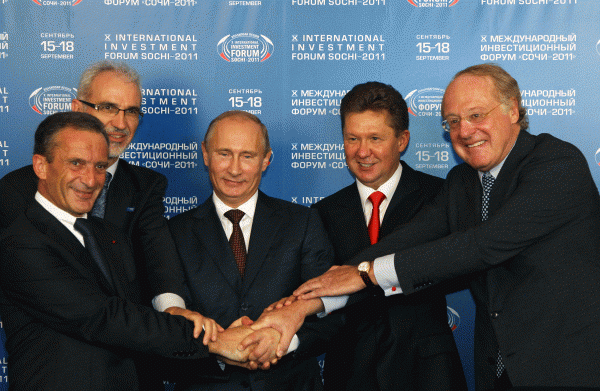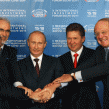
Gazprom’s South Stream Shareholders Sign Agreement On Black Sea Offshore Pipeline
Publication: Eurasia Daily Monitor Volume: 8 Issue: 173
By:

On September 16 in Sochi, Russian Prime Minister Vladimir Putin presided over the signing of a shareholders’ agreement to build the offshore section of the South Stream gas pipeline (Interfax, September 16, 17).
The agreement pertains to the pipeline’s section on the seabed of the Black Sea, from Russia to an assumed landfall point in Bulgaria. Unlike memoranda of understanding signed during the last four years, this agreement is described as legally binding. The reconfigured consortium includes Russia’s Gazprom with 50 percent plus one controlling share, Italian ENI with 20 per cent, and German Wintershall Holding and Electricite de France with 15 percent each. ENI, having previously held 50 percent in parity with Gazprom, has ceded most of its stake to the new German and French entrants.
Official information about the project remains sketchy and largely outdated. In the absence of a feasibility study, the signing event in Sochi only rehashed information dating back for the most part to February 2009. Thus, the 950 kilometer section on the seabed of the Black Sea is anticipated to cost 10 billion Euros ($13.7 billion). The sections planned to be laid overland, Bulgaria-Serbia-Hungary-Austria and Bulgaria-Greece-Italy (with a further offshore section, Greece-Italy) are expected to cost another 15 billion Euros ($20.55 billion) for a total of 25 billion Euros ($34.25 billion), according to the signatories in Sochi. They gave no information about financing the project on such a scale.
An additional cost factor was officially mentioned for the first time on this occasion: namely, building new gas pipeline capacities from Siberia to Russia’s Black Sea coast. No estimate is yet being suggested for this additional investment. As always, Gazprom claims that the system would ultimately carry a total of 63 billion cubic meters (bcm) of gas per year, without however identifying any source of gas, in Russia or elsewhere, for this project.
Under a concept announced in 2010, and restated by Gazprom’s CEO Aleksei Miller at the Sochi signing event, the consortium proposes to build the Black Sea offshore section in four consecutive stages. These would involve four parallel loops with a capacity of some 15 bcm per year for each loop. The new target date for completing the first loop is 2015. This stage-by-stage concept implicitly acknowledges the bluff involved in the 63 bcm offer. It also reflects South Stream’s real goal to pre-empt the construction of the EU-backed Nabucco project. Moscow apparently calculates that even a vague prospect of 15 bcm per year, reaching the Balkans on the same timetable as Nabucco, would discourage investment in the EU-backed pipeline.
According to Miller, Gazprom is currently drafting the South Stream Consolidated Feasibility Study, which covers the offshore and onshore pipeline sections in all the host countries. Gazprom has been drafting the consolidated study since 2009, but it necessitated constant revisions. Moscow tried to play off some potential participant countries against others; and yet other countries lost confidence altogether in the project.
South Stream’s sections in each country are supposed to be jointly owned and operated by Gazprom with the host country. In March 2011, however, the European Union’s Third Energy Package went into effect. This creates almost insuperable legal and regulatory hurdles to the construction of Gazprom-controlled pipelines in EU member countries.
According to Wintershall CEO, Rainer Seele, the company has joined South Stream to increase its market share in Romania and Bulgaria, as well as enter new markets in that region. Wintershall intends to sell gas from fields it operates in Siberia in partnership with Gazprom (www.wintershall.com, September 16; Deutsche Welle, September 16).
This sounds questionable, however. Would small market share increases, in markets that are limited to begin with, justify investing billions of Euros in South Stream’s offshore section and in new pipeline capacities from Siberia to Russia’s Black Sea coast, which the consortium says are needed (see above)? Electricite de France’s press release does not state the company’s specific interest in joining this project. It claims in general terms that South Stream would contribute to covering European demand for natural gas, again without identifying supply sources (www.press.edf.com, September 16).
Putin and Gazprom seem to have timed this signing event for political impact on two other unfolding processes. One is the dispute over the price of Russian gas to Ukraine, and more broadly over the control of Ukraine’s gas transit system. Russia’s periodic threats to bypass Ukraine via South Stream serve to intimidate the Ukrainian government. President Viktor Yanukovych reacted to the Sochi event with a bluff of his own: he challenged Moscow to build the South Stream pipeline overland via southern Ukraine, at a fraction of the cost of a seabed pipeline across the Black Sea (Interfax-Ukraine, September 17).
The other unfolding trend is the EU’s hands-on involvement with the Nabucco and trans-Caspian pipeline projects (“European Union Officially Endorses Trans-Caspian Pipeline To Link Up With Nabucco,” EDM September 20). Moscow hopes to frustrate these projects by creating the appearance of a competitive threat with South Stream. The short-term goal is to delay Nabucco by portraying it as redundant and discouraging European investment. The longer-term goal is to cut off Turkmenistan from Europe, which would be the result of delaying Nabucco indefinitely. In that case, Russia could offer to buy significant volumes of Turkmen gas and re-export it to Europe, with South Stream as a possible route.
That was South Stream’s initial planning concept when Putin first unveiled it in 2007. The project’s credibility, however, is now lower than at any time since its inception. The EU’s involvement in the Caspian basin, Turkmenistan’s interest in bypassing Russia, and energy market reforms in the EU’s new member countries, have all undercut the South Stream project. Moscow can still keep it alive as a virtual project, however, using favor-for-favor tradeoffs with its West European corporate allies.




